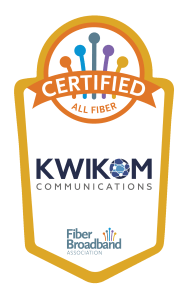The Environmental Benefits of Fiber Internet
At KWIKOM, we’re dedicated to providing high-speed internet while also being mindful of our impact on the environment. One of the most effective ways to reduce our carbon footprint and promote sustainability is through the use of fiber internet. This technology not only enhances our connectivity but also offers significant environmental benefits. Let’s explore how fiber optic internet contributes to a greener planet.
1. Energy Efficiency
Fiber optic cables transmit data using light, which is far more efficient than the electrical signals used by traditional copper cables. This method requires less energy to transmit data over long distances, reducing the overall power consumption of internet infrastructure. By choosing fiber optic internet, you’re supporting a more energy-efficient technology that helps lower greenhouse gas emissions.
2. Longevity and Durability
Fiber optic cables are more durable and have a longer lifespan compared to copper cables. They are less prone to damage from environmental factors such as extreme weather conditions and electromagnetic interference. This durability means fewer replacements and repairs, which in turn reduces waste and the environmental impact associated with manufacturing and installing new cables.
3. Reduced Physical Footprint
Fiber optic networks require less physical infrastructure compared to traditional networks. This is because fiber optic cables can carry significantly more data at higher speeds, reducing the need for extensive cabling and large network facilities. A smaller physical footprint means less disruption to natural habitats and reduced resource consumption for network maintenance and expansion.
4. Lower Maintenance Requirements
The robust nature of fiber optic cables results in lower maintenance needs. They are less susceptible to issues like corrosion and signal degradation that commonly affect copper cables. This decreased need for maintenance translates to fewer service calls, reduced vehicle emissions from technicians traveling to make repairs, and a lower overall environmental impact.
5. Support for Telecommuting and Remote Work
Fiber optic internet provides the high-speed connectivity necessary for effective telecommuting and remote work. By enabling more people to work from home, we can reduce the number of commuters on the road, leading to lower carbon emissions from transportation. Additionally, this shift can decrease the demand for large office spaces, further reducing energy consumption and the environmental impact of commercial buildings.
6. Future-Proof Technology
Investing in fiber optic infrastructure is a forward-thinking approach that supports the growing demand for high-speed internet without requiring frequent upgrades. As our digital needs expand, fiber optic technology can easily scale to accommodate increased data loads, ensuring a sustainable solution for the future. This reduces the need for continual infrastructure overhauls, which can be resource-intensive and environmentally taxing.
Conclusion
At KWIKOM, we believe that technology should not only advance our lives but also protect our planet. Fiber optic internet stands out as a sustainable choice that offers numerous environmental benefits, from energy efficiency to reduced waste and lower emissions. By opting for fiber optic internet, you’re not only enjoying superior connectivity but also contributing to a greener, more sustainable world.
If you’re interested in learning more about how fiber optic internet can benefit both you and the environment, feel free to reach out to our team at KWIKOM. Together, we can make a difference by embracing technologies that support a healthier planet.




